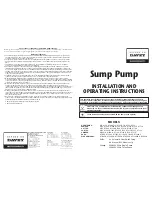
9
WARNING The pressure reading shown on the pump
hydraulic pressure gauge must not exceed the maximum
rating of the lowest rated hydraulic component in the circuit.
Failure to observe this instruction may result in catastrophic
failure, high pressure oil leakage and/or skin penetration.
Serious personal injury or death could result.
9. After
confi rming the proper setting, press down on the air
adjustment knob to lock the setting.
5.10 Air Removal
Trapped air must be removed from the hydraulic cylinder(s) and
hoses before the pump is placed into operation.
1.
Move the air on-off control to the ON position.
2. Under no load, repeatedly cycle the cylinders (or other
hydraulic actuators) from the fully extended to fully retracted
position until operation is smooth. Repeat this procedure for
each valve station.
Smooth operation indicates that air has successfully been
removed from the system.
3.
Move the air on-off control to the OFF position.
4. Check the oil level in the pump hydraulic reservoir. If oil level
has dropped, add additional oil to the reservoir as required.
NOTICE
Refer to Section 5.3 of this manual for hydraulic oil
requirements and reservoir fi lling instructions.
5. Check the air pressure setting after performing air removal
procedures. The air pressure setting (and the corresponding
hydraulic pressure setting) may drop slightly after the pump
has been operated for the fi rst time. If readjustment is
required, refer to the instructions in Section 5.9.
6.0 OPERATION
Specifi c pump operation procedures will vary, depending on
control valve type and confi
guration, workholding devices
used and other factors. For detailed operating instructions and
related information, refer to the instruction sheet included with
your hydraulic valve(s), cylinder(s) or other actuator(s). Refer to
Section 6.1 for a general overview of pump operation. Also follow
the additional instructions and precautions contained in sections
6.2 and 6.3 of this manual.
6.1 Overview of Operation
Typical operation - with standard closed center or fl oat center
control valves (pressure holding type):
• The pump will start immediately if the air on-off control is
moved to the ON position while the control valve is in the
neutral position. The pump will stop automatically (and remain
idle) when pressure reaches the user-adjustable pressure
setting.
• If the pump is idle, and the control valve is moved from the
neutral position to either the advance or retract position, the
pump will start immediately. The pump will stop automatically
when pressure reaches the user-adjustable pressure setting.
Typical operation - with spool type closed center or fl oat center
control valves (non-sealed type):
• When the air on-off control is in the ON position and the control
valve is in the neutral position: The pump will start and stop as
needed to maintain the user-adjusted pressure. This feature
helps compensate for the normal internal oil leakage present
in a spool type control valve.
• Operation is otherwise the same as described for the standard
(pressure holding type) control valves.
NOTICE
It is mandatory that the operator has a full understanding
of all instructions, safety precautions and applicable safety
regulations before operating any high force hydraulic equipment.
If any questions or concerns, contact Milwaukee Cylinder
customer service representative.
6.2 Maximum Hydraulic Working Pressure
Rated maximum hydraulic working pressure varies, depending
on the pump model:
• MAP07 Series: 1920 psi [132 bar].
• MAP15 Series: 2760 psi [190 bar].
• MAP30 Series: 5280 psi [364 bar].
WARNING
Maximum hydraulic system pressure is limited by an internal
safety relief valve that is set slightly higher than the pump's
maximum rated hydraulic working pressure. Do not attempt
to adjust, bypass or alter this valve. It is factory set and is not
user-adjustable.
Be certain that all hydraulic hoses, hydraulic cylinders and
any other connected hydraulic devices are rated at or above
the maximum hydraulic working pressure for your pump
model.
Serious personal injury or death could occur if these
instructions and precautions are not followed.
6.3 Relieving Pneumatic and Hydraulic Pressure
WARNING
Failure to observe the following instructions and precautions
could result in dangerous high pressure oil leakage and
possible skin penetration. Death or serious personal injury
could result.
Perform the following procedure before disconnecting any
hydraulic hoses or lines from either the pump manifold or a
connected device, before loosening any hydraulic fi ttings or
before servicing the pump or any connected devices:
1.
Move the pump air on-off control to the OFF position. See Figure 9.
2. Disconnect the air supply hose from the pump air inlet
connection. Be certain that the pump air pressure gauge
indicates zero (0) psi/bar. See Figure 10.
3. Cycle the hydraulic control valve(s) to relieve residual
pressure in the pump hydraulic system (this will also remove
residual pressure in the pump pneumatic system).
Figure 11 - Pump Hydraulic Pressure Gauge
4.
Verify that all hydraulic pressure is completely relieved:
-
Check that the pump hydraulic pressure gauge indicates
zero (0) psi/bar. See Figure 11.
-
Verify that other hydraulic pressure gauges in the system (if
present) also indicate zero (0) psi/bar.






































